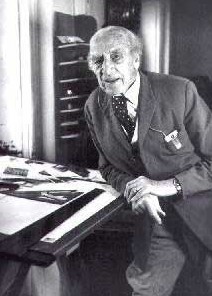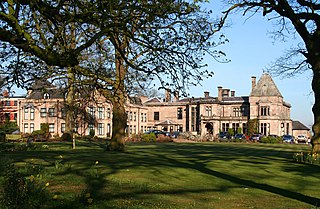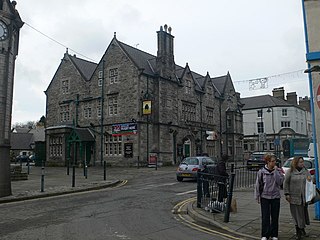
Portmeirion is a folly tourist village in Gwynedd, North Wales. It lies on the estuary of the River Dwyryd in the community of Penrhyndeudraeth, 2 miles (3.2 km) from Porthmadog and 1 mile (1.6 km) from Minffordd railway station. Portmeirion was designed and built by Sir Clough Williams-Ellis between 1925 and 1975 in the Baroque style and is now owned by a charitable trust. It has served as the location for numerous films and television shows, most famously as "the Village" in the 1960s television show The Prisoner.

Sir Bertram Clough Williams-Ellis, CBE, MC was a Welsh architect known chiefly as the creator of the Italianate village of Portmeirion in North Wales. He became a major figure in the development of Welsh architecture in the first half of the 20th century, in a variety of styles and building types.

Llanystumdwy is a predominantly Welsh-speaking village, community and electoral ward in the Eifionydd area of Gwynedd in Wales. The village lies on the southern coast of the Llŷn Peninsula, with a beach facing Cardigan Bay, between Criccieth and Pwllheli at the point where the A497 road crosses the Afon Dwyfor.

Bodysgallen Hall is a manor house in Conwy county borough, north Wales, near the village of Llanrhos. Since 2008 the house has been owned by The National Trust. It is a Grade I listed building, currently used as a hotel. This listed historical building derives primarily from the 17th century, and has several later additions. Bodysgallen was constructed as a tower house in the Middle Ages to serve as defensive support for nearby Conwy Castle. According to tradition, the site of Bodysgallen was the 5th century AD stronghold of Cadwallon Lawhir, King of Gwynedd, who had wide-ranging exploits as far as Northumberland.

Rookery Hall is a Georgian style mansion located off the B5074 road near the village of Worleston in Cheshire, England. Dating originally from 1816 but extensively altered in the late 19th century, the hall is listed at grade II. Since 2001 Rookery Hall has been owned and managed by Julia Hands, Hand Picked Hotel Group. The Conference centre and Health Club and Spa were added in 2011.
Sir Hugh John Ellis-Nanney, 1st Baronet, was a Welsh landowner, magistrate and political candidate.

The Bull Hotel is a Grade II-listed building in Llangefni, Anglesey, built during the nineteenth century in a seventeenth-century vernacular style. It replaced an earlier inn built on the same site.

The Old Town Hall is a municipal building in the Market Place in Somerton, Somerset, England. The building, which is used as an arts centre, is a Grade II listed building.

Fenton Town Hall is a municipal building in Albert Square in Fenton, Staffordshire, England. It is now occupied by local businesses, a café and an art gallery.

Llanidloes Town Hall is a municipal building in Great Oak Street, Llanidloes in Powys, Wales. The structure, which is the meeting place of Llanidloes Town Council as well as the home of the Llanidloes Museum and the Llanidloes Public Library, is a Grade II listed building.

Cardigan Guildhall, is a municipal building in Pendre, Cardigan, Ceredigion, Wales. The structure, which is now used as an art gallery and community events venue, is a Grade II* listed building.

Llangollen Town Hall, is a municipal building in Castle Street, Llangollen, Denbighshire, Wales. The structure, which is the meeting place of Llangollen Town Council, is a Grade II listed building.

Denbigh Town Hall, is a municipal building in Crown Lane, Denbigh, Denbighshire, Wales. The structure, which is the meeting place of Denbigh Town Council, is a Grade II* listed building.

Bala Town Hall, known in the late 19th century as the County Hall, is a municipal building in Bala, Gwynedd, Wales. The structure, which is now used as a restaurant, is a Grade II listed building.

Tremadog Town Hall is a municipal building on Stryd Fawr, in Tremadog, Gwynedd, Wales. The structure, which was most recently used as a shop, is a Grade II* listed building.

The Old Market Hall is a municipal building in the Market Place, Blaenau Ffestiniog, Gwynedd, Wales. The structure, which also served as the Town Hall, is a Grade II listed building.

Pwllheli Town Hall is a municipal building in Penlan Street, Pwllheli, Gwynedd, Wales. The structure, which now operates as an arts centre, is a Grade II listed building.

Grosmont Town Hall is a municipal building in Grosmont, Monmouthshire, Wales. The structure, which is the meeting place of Grosmont Community Council, is a Grade II listed building.

Darvel Town Hall is a municipal building in West Main Street, Darvel, East Ayrshire, Scotland. The structure, which is used as a library and a community events venue, is a Category B listed building.

The Old Town Hall is a municipal building located on Penlan Street in Pwllheli in Gwynedd in Wales. The structure, which accommodates offices and meeting place of Pwllheli Town Council, is a Grade II listed building.





















